The 1st International Workshop
Aging in Africa and Asia:
Perspective and Prospective from Public Health and Ethnography
Date: March 6th, 2014
Venue: Shimba Hills Lodge Hotel, Kwale, Kenya
Program
Participant List
Download the full report
Preliminary Session
Aging in Africa and Asia
– Perspective and Prospective from Public Health and Ethnography
By Dr. Ken MASUDA, Nagasaki University
Introduction
The International Workshop “Aging in Africa and Asia: Perspective and Prospective from Public Health and Ethnography” is held in Kwale in the Republic of Kenya as a research meeting of our two Grant-in-Aid Projects. The conference should appear its particularity in a sense that doctors and professors both in public health and ethnography participate and collaborate in a current and future issue.
The meeting consists of two parts. In the first part, topics on aging care and non-communicable diseases (NCDs) both in Kenya and Japan will be presented from the perspective of health policy. In the second part, some ethnographic findings on elderly life and care will be provided by experienced anthropologists.
Global aging is rapidly becoming a focus on public attention. Organizations predict a rapid population growth that in 2100 the worldwide population will reach ten billion, 40% of which will exist in Africa. The process of population growth accompanies that of changing demographic structure. The age of population aging is approaching Africa.
The population aging is introduced by two different phenomena on health improvement: epidemiological transition and demographic transition. Epidemiological transition describes changes in disease pattern. The population grows older, and noninfectious diseases become the main cause of ill health.
The model of demographic transition explains the process from “high birth rate and death rate” to “low birth rate and death rate”.
Stage 1: death rates and birth rates are high and roughly in balance
Stage 2: the death rates drop rapidly due to improvements in food supply and sanitation, which increase life spans and reduce disease.
Stage 3: birth rates fall due to access to contraception, increases in wages, urbanization, a reduction in subsistence agriculture, an increase in the status and education of women, a reduction in the value of children’s work, an increase in parental investment in the education of children and other social changes. Population growth begins to level off.
Stage 4: both low birth rates and low death rates.
Japan, a country where people enjoy long life expectancy, has experienced both rising life expectancy and/or declining birth rates in the past decades, however the changes result in many other issues such as medical care for non-communicable diseases, elderly care, welfare policy, etc.
Approaches to Elderly Life and Care
The meeting is organized as a joint session of two research projects.
A research project organized by Professor Nanako TAMIYA (Tsukuba University) focuses on global aging from the perspective of healthcare service. Tsukuba University held an intensive program on global aging in 2013 where students, undergraduates to Ph.D candidates, Asians and Africans, met, reported and discussed issues on population aging and care in each country. The discussion leads us to understanding current on-going transition of social institution like elderly care, family and kinship tie as well as relationship between family and community.
Professor Hideki YAMAMOTO (Teikyo University) and Ken MASUDA (Nagasaki University) are appointed to work on elderly life and care in Africa. Our strategy of research is structured basically in four steps: 1. HDSS research and analysis, 2. complementary approach with qualitative description, 3. integration, and 4. prospects and proposal.
There appear some difficulties in approaching aging issue in Africa. Who should be classified as the elderly? By which criteria should the elderly be identified? How do they live in their elderly life in certain social environment?
As Aboderin (2010) mentions, theories in African gerontology since 1960s have been developed based on “modernization theory” by which researchers views society transition as modernization and westernization process; changes from familism and filial obligations to individualism, from rural to urban, from traditional and pre-industrial to modern. However, the perspective is not strictly based on quantitative and qualitative in-depth evidences.
We are now preparing a research proposal to conduct both qualitative and quantitative research on current situation of elderly life and care in Kwale with cooperation of health and demographic surveillance system (HDSS) that is launched by KEMRI and Nagasaki University. Through the investigation, it is expected to deeply identify geographical distribution, economic status, health condition, household circumstances of elderly people.
It is significant to describe quantitatively and ethnographically for detailed understanding of elderly life and care. Anthropology has a technique of detailed description by participant observation and of understanding family and kinship relation as cultural system. Some participants of the meeting are anthropologists who have been engaged in ethnographic research in Kenya, Uganda and Ethiopia, and members of Japan Association for African Studies.
The purposes of the meeting are three. First purpose is promotion of exchange of knowledge and information among participants. The second is sharing ethnographic insights on elderly and kinship relations in the cases from Kenya, Uganda, Zambia and Ethiopia. Thirdly, we explore the possibility of long-term relation between Asia and Africa on the forthcoming social problem.
Reference
Aboderin, I (2010) “Global Ageing: Perspectives from Sub-Saharan Africa.” In SAGE Handbook of Social Gerontology. SAGE Publications, pp. 405-419
Notes
The meeting is organized with financial supports from two grant-in-aid research projects.
- Interdisciplinary Study of “Premature Aging” and Cultural Diversity of Aging Care in East Africa. (Project Leader: Ken MASUDA, Nagasaki University) Grant-in Aid for Scientific Research (B) of the Ministry for Education, Culture, Sports, Science and Technology, Japan.
- Challenges of Global Aging without Borders: Studies on the Recommendations by an Interdisciplinary Network Originating in Japan to Support the Sharing of Experiences and Mutual Respect. (Project Leader: Nanako TAMIYA, Tsukuba University) Grant-in-Aid for Scientific Research of the Ministry of Health, Labour and Welfare (Promote global health challenges research project)
Presenters and Commentators
- Muthoni GICHU is Head of Health and Aging Unit, Ministry of Health.
- Hideki YAMAMOTO is professor of public health and global health at the Graduate School of Public Health, Teikyo University.
- Haruko NOGUCHI is professor of health economics at the Faculty of Political Science and Economics, Waseda University.
- Gen TAGAWA is associate professor of cultural anthropology at the Faculty of International Studies, Hiroshima City University.
- Shinji MIYAMOTO is associate professor of Geography and Environmental History at the Faculty of Biosphere-Geosphere Science, Okayama University of Science.
- Itsuhiro HAZAMA is assistant professor of anthropology at the Graduate School of International Health Development, Nagasaki University.
- Kaori MIYACHI is assistant professor at Gender Equality Office, Saga University.
- Mariko NOGUCHI is graduate student at the Graduate School of Asian and African Area Studeis, Kyoto University.
- Ken MASUDA is associate professor of social anthropology at the Graduate School of International Health Development and Faculty of Environmental Studies, Nagasaki University.
Session I: African, Asian and Global Aging
The Role of the Community for the Ageing Society
– Experiences in Japan and Zambia
Prof. Hideki YAMAMOTO, Teikyo University
Japan has achieved the highest longevity and lowest infant mortality in 1977 and enjoyed the healthy society. This improvement has been done mainly after the 2nd world war. For instance, the infant mortality of Japan in 1947 was 78/1,000 live birth and reduced 10/1,000 in 1975. Although the economic development and introduction of health system such as health insurance have done great contribution to those improvements, the role of the community to improve the sanitation to protect from the infectious diseases and to promote the good health should be emphasized.
When Japan hosted the 5th Tokyo International Conference for African Development (TICAD5) in June 2013, presidents or prime ministers from 47/54 African countries participated. Post MDG after 2015 is the agenda of the conference. Universal Health Coverage (UHC) and Non-Communicable Diseases (NCD) are the important agenda since the epidemiological and demographic transition affects the whole society after African countries improve the health status after the achievements of the MDGs.
On the meanwhile, the low fertility rate caused the rapid increase of the proportion of the elderly peoples. Japan is a leading country for Ageing. The proportion of the 65years or older exceeded 23.0% in 2010 and exceed 25% in 2013. Japan introduced the Long-Tem Care (LTC) insurance system introduced in 2000 to support the elderly people in the society, and the role of the mutual support in the community is also needed.
“Kominkan” (public-private-halls) is developed in Japan and legalized in 1947 as the social education act and institutionalized as Japanese system in the community for the platform of the Community Based Organization to promote the community participation. Out of 47 Japanese prefectures, the longevity of Nagano is highest and healthy. One of the factors is the active social participation in the community at Kominkans.
This Kominkan system has been modified and introduced as Community Learning Centers (CLC) in Asian countries by UNESCO. Currently, Kominkan model was expanded to African countries in Lusaka, Zambia to promote the Education for Sustainable Development (ESD). The model of Kominkan/CLC would be helpful social resource for the coming ageing society in Africa.
References
- Tamiya N, Noguchi H, Nishi A, Reich MR, Ikegami N, Hashimoto H, Shibuya K, Kawachi I, Campbell JC. Population ageing and wellbeing: lessons from Japan’s long-term care insurance policy. The Lancet.378(9797):1183-92. 2011
- Overson Shumba and Hideki Yamamoto, International Cooperation by utilizing, Kominkan/CLC case of Chawama in Zambia, Education for Sustainable Development (ESD) and Kominkan/Community Learning Centre(CLC),pp208-227 ,Okayama University Press,2013
Session I: African, Asian and Global Aging
Japan’s response to ageing: Challenges in socializing informal care with a tradition of family care
Prof. Haruko NOGUCHI, Waseda University
Japan’s public long-term care insurance (LTCI) system was introduced in 2000, as care for older adults has become a social security issue as well as a family catastrophe. It provides formal care service for eligible beneficiaries with low copayment. Cash benefit for informal caregivers has not included yet in Japanese system, while other OCED countries have emphasized support for informal caregivers as potential human resources for their systems. Why did Japan choose this system? How much has the current LTCI system succeeded in “socializing care’? The impact of LTCI is evaluated in before-after difference in health, stress, and labour participation among female family caregivers by use of several nationally representative and community-based surveys from 1995 to 2007. Although the formal service use under LTCI was widely accepted and enhanced female labour participation, its impact on family caregivers’ health and perceived stress reduction was only minimum up to 2007. Japanese challenge of the shift from traditional family-based toward society-based care still needs a breakthrough in family policies to achieve the efficacy and sustainability of the LTCI.
Session I: African, Asian and Global Aging
Non-Communicable Diseases and aging in Kenya:
A case of Kenya
Dr. Muthoni GICHU A. P., Unit of Health and Aging, Ministry of Health Kenya
This presentation aims to highlight the health status and welbeing of the older persons in Kenya from various studies conducted.
In Kenya like in other Sub-Saharan countries the population of older persons is increasing. There has been a steady rise from 1 million in 1989 to 1.9 million in 2009, which is 4.9% of the entire population and is projected to rise to approximately 8.5 million 8.7 % of the population by 2050.
Health challenges faced by older people in developing countries are often neglected amidst a wide range of competing priorities. Chronic Non-Communicbale Disesaes are now a common cuase of morbidity and mortality and associated with aging. They deliver a double burden of morbidity and poverty in that medical expenses are covered through family resources.
Against this background, the discussions on challenges of ageing and health are concerned about the heightened vulnerability of older persons to detrimental health outcomes in two ways. First the older persons are deemed to be at a higher risk of ill-health and disability from age related chronic non-communicable diseases due to a life time exposure to a growing prevalence of modifiable NCD risk factors. Secondly, they are believed to lack access to even basic health care commpared to the younger age-groups.
There has been inadequacy in the preparedness on availability of medicines, delivery of services and personnel suggesting an age related exclusion.
Session II: Ethnographers’ Insights
Gerontocracy in the on-going modernization:
Changes and Continuity of Life Course among the Banna, Southern Ethiopia
Dr. Ken MASUDA, Associate Professor, Nagasaki University
Gerontocracy used to be, and still is, a keyword that characterizes African “traditional” societies. Gerontocratic society is where older person, generally male, enjoys more prestige, dignity and authority than the younger. This study outlines how modernization process lead changes and continuity of life course to the Banna people in southern Ethiopia. The Banna is an Omotic afro-pastoralist group living South Omo Zone.
In this study, the term “modernization” has political and hegemonic implication in such a state like Ethiopia where Amhara-centered imperial domination annexed ethnic minorities in the south, while so-called amharalization, becoming Christian, speaking Amharic and adoption of Amhara “civilization”, had embodied modernity in 20th century. Since 1990s, the early phase of post-socialist EPRDF regime, Ethiopia has been implementing new development policies especially in socio-developmental sectors that would result in gradual transition of social norms among the peripheral people. Gerontocratic and male-centered social structure of the Banna would inevitably adjust itself to the new era when increase of education opportunity in villages do not tolerate people to indulge in life in traditional norms, and when Health Extension Program (HEP) induces lower child mortality and longer average lifespan.
Traditional life course of Banna men is defined by a kind of grading system; the donza system. A boy (naasi) becomes ukuli when he starts preparation for initiation ritual (atsa). After the ritual he becomes a maz as he has his hair shaved and spends for weeks or months under strict ritual regulation. A maz then becomes a donza, adult man, once he has undergone the engagement ritual with his fiancée.
Dignity of donza is recognized in two aspects; agedness and masculinity. They are much subdivided from younger to older donza. In the past when only men who experienced killing large animal or enemy were permitted to be into adult stage, the dignity of donza was secured by showing his bravery and achievement. The characteristics of donza-centered gerontoctatic social norms is expected to change as on-going “modernization” processes introduce changes and continuity of a sense of value among the people.
Session II: Ethnographers’ Insights
Ritual Elderhood in the Age System of the Borana of Southern Ethiopia
Dr. Gen TAGAWA, Associate Professor, Hiroshima City University
This study examines ritual elderhood in the age system of the Borana people, based on ethnographic fieldwork. Many ethnic groups in East Africa maintain age systems, and numerous previous ethnographic studies of such systems have described them as social organization. The Borana are Oromo-speaking people who live in southern Ethiopia and northern Kenya. They maintain the most complicated age system called gadaa.
The age system of the Borana is based upon eight grades, which are called respectively dabballe, gamme, kuusa, raaba, doori, gadaa, yuuba, and gadaamojji. When the members of the generation set reach these grades, they are called by the names of the grades. A generation-set used to take eighty eight (or ninety six since 1980) years to complete all the grades.
A new generation-set is formed every eight years. All men are to be recruited into the fifth generation-set after his father’s generation-set and all siblings belong to the same generation-set. As the generation-set is never closed, it continues to recruit members. Consequently, the age gap amongst the members of the same generation-set inevitably expands over time.
Therefore, the gadaa system is not an administrative institution, but rather a ritual complex, which represents manhood and fertility of the Borana. Since councilors of the generation-set perform those rituals, all Borana males are not required to pass through all grades. However, every male has a ritual duty to perform the transition ceremony of the most senior gadamojji grade. In the age system, the old man who has completed the rite of passage of the gadamojji grade reaches jaarsa which meant an elder. This study explores the elderhood of the Borana by focusing on the ceremony of the gadamojji grade.
Session II: Ethnographers’ Insights
Elderly people in Pastoral Society:
A Case Study of the Karimojong in Uganda
Dr. Itsuhiro HAZAMA, Assistant Professor, Nagasaki University
This paper examines the possible contribution of fieldwork conducted in a pastoral society in Karamoja in northeastern Uganda to delineating the diversity of care provided to elderly individuals. Fieldwork-based research regarding gerontology in African societies has shown that many societies approach the care of elderly individuals on the basis of a social exchange theory of the body and property. A sense of socially engendered moral debt, awe of transcendent existence, and economic rationality encourage elderly people to survive, despite their disadvantaged and socially alienated status. At the same time, these experiences also allow them to appreciate their power. Drawing on individual experiences of aging that are embedded in, and shaped by, the reality in which people live, cultural anthropology has elucidated some of the cultural diversity associated with the experience of aging. In other words, the subjective experience and meanings, including the cues associated with life stages such as menopause and geriatric conditions such as dementia, vary cross-culturally, as they are strongly connected with the social categories associated with age. In the context of such a culturally and morally relativistic perspective, disengagement theory has given way to an aesthetic view of growing older. The poetics of the lives of elders have been ethnographically described, intertwined with the symbols and meanings that define and construct each period in relation to others. However, the existence of the socially constructed body (i.e. as the object of ethnographic description) may result in unsuccessful aging, whereby the body acts under the influence of introjected negative aspects of communal life by committing suicide or is subjected to death-hastening non-supportive treatment or involuntary confinement. Siding with the world and the relation of distress and life that the sick experience, which is beyond pathological intervention, can be the basis of a critical ethnography of gerontology, showing the correlation between the ineffectiveness of therapy and the indignity to human beings.
Session II: Ethnographers’ Insights
Daily Life of the Elderly in Rural Southwestern Ethiopia
Dr. Mariko NOGUCHI, Kyoto University
The presentation aims to present a study describing how the elderly make a living and organize their living arrangements in a rural setting in Ethiopia.
In Africa, as in other regions of the world, the number of people in old age has increased rapidly in recent years. The absolute number of older adults in Ethiopia increased fourfold between 1950 and 2005. The United Nations has estimated that the number of people aged older than 60 years in sub-Saharan Africa may quadruple by 2050 (UN 2012).
Many scholars insist that the extended family as “a traditional welfare system” has eroded, thereby leaving elderly people vulnerable. For example, rapid urbanization has influenced the young generation to move to cities, whereas the death of young people caused by the HIV/AIDS pandemic has left only the elderly and children (Apt 1997, Eyasuu et al. 1987, Nyambedha et al. 2003). However, actual long-term investigations of these issues have not been conducted. Therefore, comparative long-term research in various areas is needed. This research offers basic data for the abovementioned purpose.
Research was conducted for a total of 20 months beginning in 2008, mainly among Aari people primarily living in one location in southwestern Ethiopia. Participatory observations and interviews were undertaken in this research.
Results showed 16 elders residing in the location, most of whom are very active. They do some arrangements in their residential pattern and livelihood activities to make a living. They manage their lives by reducing a part of their daily hard work, which they ensure by living near those who are related to them. Most of them, for example, live with their families, such as their spouse, children, and grandchildren. Younger family members, wives, or children often support the livelihood activities of these older adults. Sons help with farming activities, such as in handling the ox-plow. If the wife cannot work hard because of her advanced age, daughters, granddaughters, or sisters could help by cooking for them.
Some of the elderly live with those who are not related to them by blood; the study found two widows who live next to their ex-husband’s relatives. In this case, communal association called idir also plays an important role in supporting the daily lives of elders.
In conclusion, after these results are taken into consideration, a possible scenario or way of reciprocal relationship building among the elderly and other members of the community is discussed.
Session II: Ethnographers’ Insights
Meaning of “Aging” for Women:
Comparison of Kenya and Japan
Ms. Kaori MIYACHI, Saga University
Gerontology has been a wide theme in several academic fields. As far, the natural and social sciences researchers are mostly focusing on the problems coming to the age of elderly, compared to the younger one. In Japan, “aging” become social issues and it is considered sometimes to be “problems”, and there are variety of services and businesses to support elderly people. It is getting to be wide from the basic services in public health and to make a profit such as “anti-aging” cosmetics etc.
Since 1990s, I have carried out several anthropological researches in the western part of Kenya, Kisii, and focused on women’s life stage events. I recognized it that it has been important in the society to step up life stages based on life events, like circumcision, marriage, and childbirth. Therefore women, who do not marry, nor bear children, are in the disgraced position, and the same time, there are several practices of adaptation of children and so on. In Japan, nowadays the percent of woman who do not marry is increasing, and it is not so surprising the couple decide not to have a child after the marriage. The declining of birthrate is social problem to increase the speed of aging in Japan. But for many women, to bear a child means to give up their carriers and women has to choose “to be a mother” or to raise her career.
In this paper, I would like to describe the differences between Kenyan local community and Japanese ones, raising some examples, focusing on elderly women in the society.
Photo Gallery
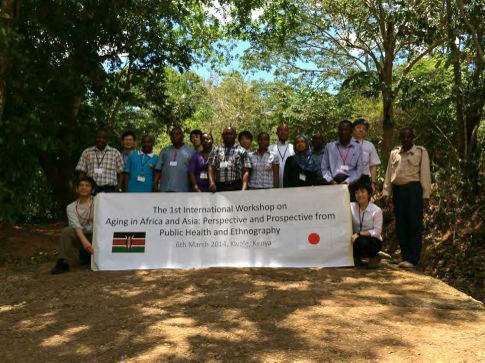
Group Picture at Shimba Lodge 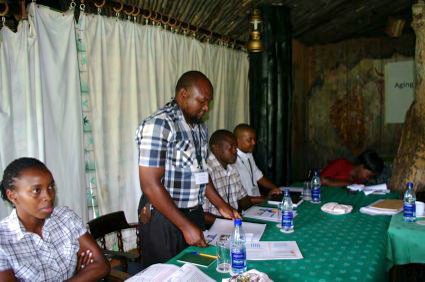
Mr. Juma Changoma MWATASA Nagasaki University 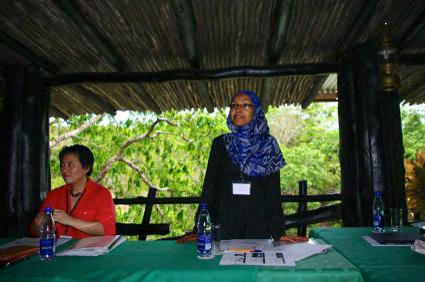
Dr. Hajar ELBUSAIDY County Director of Health, Kwale 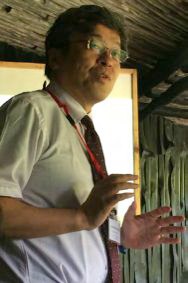
Prof. Hideki YAMAMOTO Teikyo University 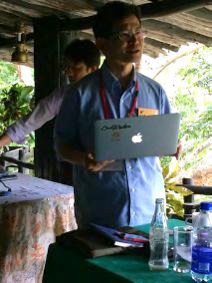
Dr. Shinji MIYAMOTO Okayama University of Science 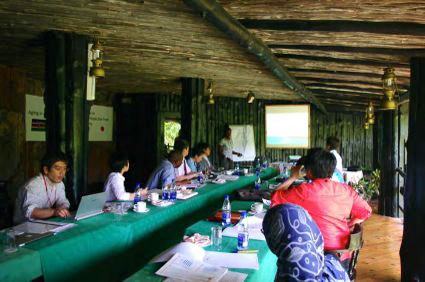
Dr. Muthoni GICHU A. P. Unit of Health and Aging, Ministry of Health Kenya 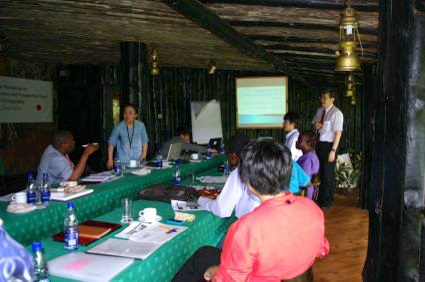
Prof. Haruko NOGUCHI Waseda University 
Ms. Mariko NOGUCHI Kyoto University 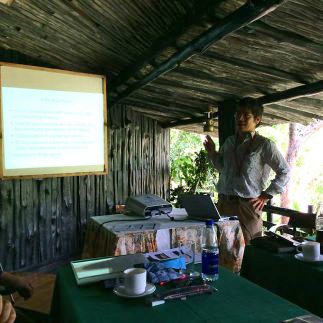
Dr. Gen TAGAWA Hiroshima City University 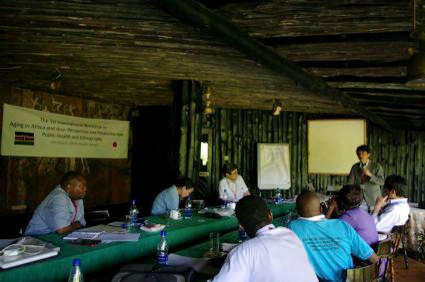
Dr. Itsuhiro HAZAMA Nagasaki University 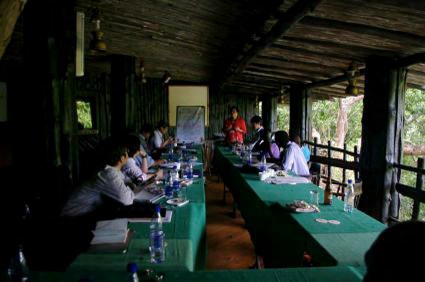
Ms. Kaori MIYACHI Saga University 
Dr. Ken MASUDA Nagasaki University